Spartans join indigenous forest protectors on XPRIZE Rainforest biodiversity quest
Saving the rainforest, biodiversity, and in the process, the planet, is often framed as a high-stakes race.
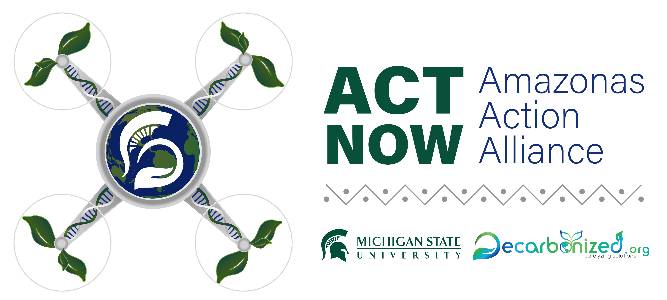
Now that race has a timetable, a $10 million prize, and ACTNOW Amazonas Action Alliance, a high-powered women-led multidisciplinary team of Michigan State University experts collaborating with innovators, indigenous rainforest protectors, and a dedicated film crew, who together are semifinalists for the XPRIZE Rainforest.
The XPRIZE Rainforest, sometimes called the Olympics of Science, is a global competition aiming to enhance the world’s understanding of the rainforest ecosystems to protect it. Michigan State University has deployed faculty, staff, and graduate and undergraduate students who are biologists, engineers, computer scientists, geographers, information technologists, and anthropologists. They bring sweeping expertise in social justice, biodiversity, climate change, plants, animals, robotics, genomics, landscape ecology, wrangling and analyzing big data.
The XPRIZE Rainforest will accelerate the innovation of autonomous technologies needed for biodiversity assessment and will enhance understanding of rainforest ecosystems by using rapid data integration to provide new wisdom about the forest as well as inspire new investment and exploration. The XPRIZE Rainforest intends to reveal the true potential of the standing forest, accelerating the development of new, just, and sustainable bioeconomies.
From an original 300 teams, 13 teams of semifinalists are competing in Singapore the first two weeks of June, each assigned to a 100-hectacre plot of dense jungle. The task: with only 24 hours to collect data and 48 hours to analyze those data, identify as many species in the plant and animal kingdom as possible. The hitch: no humans can set foot inside the forest plot.
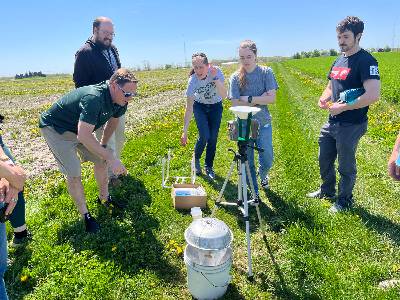
MSU XPRIZE Rainforest team members Eric Benbow, Nicholas Panchy of ICER, Phoebe Zarnetske and Department of Entomology’s Kelly Waters and Alex Rakestraw examine a tripod equipped with motion-detecting cameras and microphones and other equipment that will be drone dropped into the Singapore rainforest. Credit: Sue Nichols
“This is supersized science and a chance to showcase our Spartan innovation and expertise – to quickly gain an understanding of what lives in such an important ecosystem,” said Phoebe Zarnetske, associate professor in the Department of Integrative Biology in the College of Natural Science and director of the MSU Institute for Biodiversity, Ecology, Evolution, and Macrosystems (IBEEM), who is the scientific lead for the XPRIZE Rainforest ACTNOW Amazonas team. "We are proud to collaborate with an incredible core membership of indigenous community members, with co-leads Fiona Bannister founder Decarbonized.org, Indrani Pal-Chaudhuri and GK Reid. Advancing the ability of the land stewards to conserve these forests is absolutely aligned with MSU’s core values.”
ACT NOW – Amazonas Action Alliance includes Amazonian indigenous leaders, scientists and entrepreneurs. Seventy Spartans have joined the team, 15 of which are in Singapore, including engineering students Gavin Gardner, Gryson Gardner, Ross Davis, and Ryan Atkinson. They are members of MSU’s Drone Research and Intelligence Flight Technology or DRIFT team, a NASA-funded student led research group developing novel use cases for autonomous drones.
“Indigenous communities throughout the world are central to this project,” Zarnetske said. “Their traditional ecological knowledge of nature is essential to include.”
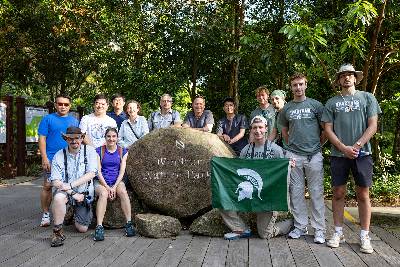
She said MSU’s team has been working directly with the team’s indigenous leaders who will be bringing their wisdom to the Singapore rainforest competition: Hector Vargas, primate expert and Sumak Allpa, of the Kichwa in Ecuador; Puwe Puyanawa, plant biologist and Spiritual Leader of the Puyanawa; and Rosane Puyanawa, singer, environment and Puyanawa youth activist leader. The MSU team filmed their work in the Amazon last year, met weekly by Zoom to advance insights, and plans further field tests in the Amazon after the semifinals to identify what’s needed to effectively monitor and protect their lands and develop accessible techniques to do so.
“MSU’s team is the only one collaborating extensively with communities that live with the biodiversity being studied,” Zarnetske said.
The team has been supported by funding from MSU’s Office of Research and Innovation, the College of Natural Science, the College of Engineering, the College of Agriculture and Natural Resources, the College of Social Science, AgBioResearch, Lyman Briggs College, International Studies and Programs, and the College of Medicine. In addition to Zarnetske, several team members also are members of the Ecology, Evolution, and Behavior Program at MSU.
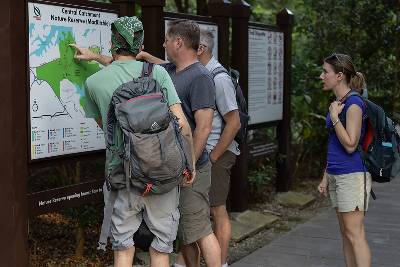
Hubert Szczygiel, NSF-NEON; Eric Benbow; Bob Goodwin, geography, environment, and spatial sciences; and Melissa Benbow, MSU College of Human Medicine, check out the map of Singapore’s Windsor Nature Park, the site of the XPRIZE Rainforest semifinals, as they get familiar with the terrain. Credit: JP Lawrence, Lyman Briggs College.
“The XPrize Rainforest competition fits perfectly with the climate research initiative outlined in the MSU 2030 Strategic Plan,” said Doug Buhler, associate vice president for the MSU Office of Research and Innovation. “We’re proud to support the project and back this team of experts as they showcase the problem-solving research prowess of Michigan State University at the international level.”
Preparations for the competition have been on a fast track: since joining the team in late February, MSU’s team has been on-campus, racing to prepare for the XPRIZE semi-finals.
In the past 12 weeks, engineering students have custom-built drones which can place motion-sensor cameras and sound recorders in the forest. They’re also fine-tuning three ground robots to collect samples of soil, water and leaf litter.
The biological samples will be quickly processed to extract environmental DNA (eDNA), a cutting-edge super sauce of the scientific world. These forest samples will contain traces of living beings shed or excreted – mucus, skin and hair, poop, as well as plants. The image and sound data will be analyzed with artificial intelligence and machine learning algorithms specially designed for biodiversity in Singapore. A diverse team of experts will be ready to quickly divine what lives in the forests.
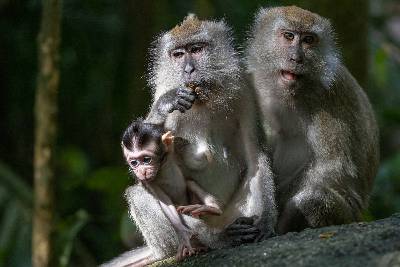
The team worked to tie down anything they could, anticipating some rainforest residents – especially these Macaques – are known to tear apart equipment. Credit: JP Lawrence, Lyman Briggs College.
The rich diversity of the tropical rainforest makes it both valuable and challenging. Monkeys that live there are notorious for tearing apart devices. The team is working to tie down everything it can to resist curious grasps. They’re pouring over maps of Singapore’s nature park for clues of what they might be facing.
The data collected will be massive. Zarnetske said they’re estimating the video, audio, and genetic samples will be some 50 terabytes.
Then the team stationed on campus will have 48 hours to analyze and make sense of what they’ve collected on MSU ICER’s new Data Machine and create a report that both shows their work and puts that knowledge into a compelling narrative.
“This experience has so many opportunities for so many people to participate in something that’s really meaningful and can make a tangible difference to people in these vital and important rainforest areas,” Zarnetske said.Banner image: MSU team members join with their ACT NOW – Amazonas Action Alliance XPRIZE Rainforest semifinalist team members to scope Singapore’s Windsor Nature Park and Central Catchment Reserve as they wait assignment of their plot to identify what creatures live there.